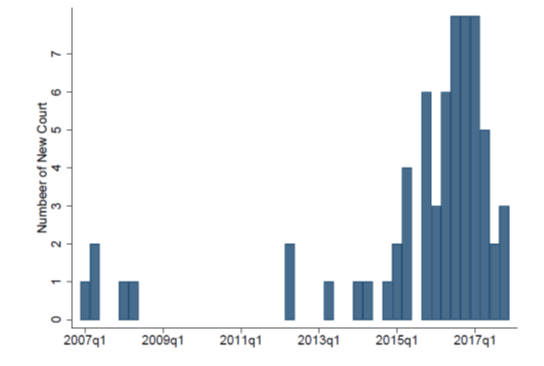Over the past decade, China has experienced a boom in the credit market, but also tremendous pressure from numerous cases of bankruptcy in the country. Since the 18th National Congress of the Communist Party of China (CPC), the Central Committee has attached great importance to the development and improvement of the socialist market economy: a sound legal system for bankruptcy has been established, market mechanisms, economic means, and legal measures have been developed to address overcapacity, and the exit mechanism of enterprises has been improved. Under the pressure of the prevailing COVID-19 pandemic and economic downturn, one should reflect on how to prevent massive bankruptcies and systemic financial risks and solve the corporate debt crisis, which is the cornerstone of sustainable economic development. Meanwhile, bankruptcy and reorganization based on marketization and legalization are of great significance for protecting the interests of enterprises and employees, attaining win-win results for all stakeholders, and maintaining stability.
Titled "Going Bankrupt in China", the lasted paper co-authored by Li Bo, Assistant Professor of the PBC School of Finance (PBCSF), Tsinghua University, and Jacopo Ponticelli from the Kellogg School of Management at Northwestern University was accepted by Review of Finance.
Analyzing data on corporate bankruptcy in China, the paper puts forward an important argument: The effectiveness of a country's bankruptcy law in protecting creditors depends not only on the integrity of the law, but also on the professionalism of the legal system and the strength of law enforcement. This is one of the few papers in international journal that examines the impact of China's bankruptcy law and bankruptcy courts on corporate bankruptcy reorganization. The empirical findings of the paper can be used as references for China and other developing countries.
The paper investigates how legal reforms affect credit markets by examining the introduction of courts specialized in bankruptcy in China. The authors construct a micro-dataset on corporate bankruptcy by collecting over 3,000 corporate bankruptcy reorganization cases between 2005 and 2020, covering the time of bankruptcy reorganization, bankrupt firms' characteristics, creditors, as well as the judges executing bankruptcy and their educational background and previous cases tried. Meanwhile, the paper exploits the staggered introduction of specialized courts across Chinese cities to identify the impact of the bankruptcy system on the trial of bankruptcy cases, the allocation of credit resources, and China's economic restructuring.
The paper focuses on two major changes in China's bankruptcy administration: While the Enterprise Bankruptcy Law enacted in 2007 strengthens creditor protection and takes an important step towards market clearing, problems remain at the level of law enforcement in bankruptcy resolution. From the judicial perspective, for example, there are many subjects involved in bankruptcy cases, the expertise of bankruptcy judges is limited, and there are no incentives in the evaluation of judges. Despite problems with the implementation of the bankruptcy law, local governments are aware of the lack of efficient bankruptcy procedures that can facilitate their liquidation or restructuring. Bankruptcy cases in China are mainly handled by local civil courts, which, similar to those in other developing countries, are characterized by limited expertise of judges in hearing bankruptcy cases and long delays in processing due to the backlog of cases. As a result, local governments have changed their idea and have come to realize that they should do more to create a favorable environment for market clearing. A sound bankruptcy system should address the relationship between governments and markets properly and create incentives within courts to facilitate bankruptcy reorganization.
According to Figure 1, the number of corporate bankruptcies did not rise but rather fell for several years after the implementation of the new bankruptcy law in 2007 (Source: Supreme People's Court of China).

Figure 1 Changes in Bankruptcy Cases
The Supreme People's Court deployed a pilot reform on bankruptcy trials at the end of 2014, and courts across China have carried out explorations according to key arrangements of the reform. According to the Supreme People's Court's recommendation in 2014, several provinces in China have attempted to introduce specialized courts in bankruptcy to address the problems such as limited expertise of bankruptcy judges and the lack of independence of judges in bankruptcy resolution. In 2016, the Supreme People's Court again issued the Work Plan on Establishing Liquidation and Bankruptcy Tribunals in Intermediate People's Courts. By the end of 2017, more than 90 new liquidation and bankruptcy tribunals had been established in superior, intermediate and basic people's courts across China (Figure 2 shows the number of new bankruptcy courts established per quarter). After the introduction of specialized bankruptcy courts, in order to speed up case handling, judges are given incentives in bankruptcy resolution as they are assigned productivity targets and are evaluated. Meanwhile, a selection mechanism for bankruptcy administrators and related incentives are established within bankruptcy courts to enhance the professionalization of bankruptcy reorganization.

Figure 2 Time of Establishment of Bankruptcy Courts
The paper first finds that the introduction of specialized bankruptcy courts has enhanced judges' expertise in hearing bankruptcy cases. With the introduction of bankruptcy courts, bankruptcy cases have been assigned to judges with higher education and more experience in bankruptcy resolution. In addition, compared with regular civil courts, the duration of proceedings at courts specialized in bankruptcy is reduced by 20% to approximately 100 to 120 days.
The paper also finds that the introduction of bankruptcy courts will solve the problems of overcapacity and state-owned "zombie enterprises" in a way more based on laws and market rules, and investigates the impact of the establishment of bankruptcy courts on credit markets in empirical analysis. The results show that the establishment of bankruptcy courts leads to a decrease in the size of bank loans and the probability of getting a loan for state-owned enterprises (SOEs). At the same time, a sound legal system creates a favorable financing environment and entrepreneurial conditions for private enterprises to obtain more bank loans, and further improves the distorted credit pricing system to unleash credit resources. By establishing an efficient information exchange mechanism and using information technology to facilitate bankruptcy trials, bankruptcy courts have established a legal and orderly interest balancing mechanism to address the current situation of financially distressed enterprises. Whether it is bankruptcy reorganization or liquidation, the introduction of specialized bankruptcy courts by Chinese local governments facilitates the shift from policy-mandated bankruptcy to a market-based bankruptcy regime. The establishment of specialized bankruptcy courts will provide a market-based approach to facilitate the orderly liquidation and exit of uncompetitive "zombie enterprises" with unsustainable debt and the reallocation of their resources to more competitive enterprises. The results of this study are consistent with the reform objectives of the Central Economic Working Conference, which emphasized the need for the judiciary to create conditions for the implementation of market-based bankruptcy procedures in resolving "zombie enterprises" and cutting overcapacity in accordance with the law.
Introductions to the authors:

Li Bo
Assistant Professor of the PBC School of Finance (PBCSF), Tsinghua University. Her research interests include empirical corporate finance, with a focus on financial distress, creditor control rights, and government policy.

Jacopo Ponticelli, Associate Professor of Finance, Kellogg School of Management, Northwestern University